A Thorough Look Into the World of On-Demand Delivery Apps
2 Mar 21 

Want food delivered to your office? Or need a taxi at the last moment? With on-demand delivery apps, everything is at your fingertips.
The endless possibilities and ultimate convenience that it offers is disrupting every industry.
And the arrival of the pandemic has undoubtedly added to its growth. On-demand delivery apps witnessed a sudden increase in their popularity in 2020. They are now in demand more than ever.
In this blog, I aim to walk you through this peaking trend and give you a complete understanding of on-demand delivery apps. So, let’s begin.
What are On-Demand Delivery Apps
On-demand delivery apps are mobile applications that allow people to order services and goods from their smartphones.
It works on the demand and supply model. By allowing people to have instant access to what they need, on-demand services have become an integral part of the modern lifestyle.
Uber, Swiggy, Ola, and Zomato are some popular on-demand delivery apps that most of you would be familiar with.
As the on-demand economy is changing and evolving, these apps are becoming more prominent in many sectors. Earlier, on-demand delivery apps used to be synonymous with taxi services. Today, it is very diverse and is popular in industries like healthcare, home services, food, travel, etc.
In short, on-demand delivery apps are empowering people to access whatever they need with a few clicks.
What are the Types of On-Demand Delivery Apps
We saw how diverse on-demand delivery apps are. Different services employ different models. There are mainly three types of on-demand business models.
1. Business to Consumer (B2C)/Enterprise to Person (E2P)
This type of app facilitates the supply of goods or services directly from businesses to end-users. This is used by specific restaurants for providing delivery service to its customers, like Dominos, Starbucks, etc. Service providers also use it to provide services from different businesses on a single platform, like UberEats, Swiggy, etc.
The on-demand B2C market is rapidly growing and has enormous potential.
2. Business to Business (B2B)/Enterprise to Enterprise (E2E)
These apps are used to connect businesses. Sometimes, a business may need to connect to another business directly for transactions or carry out its operations. The B2B apps can be vertical (serving single industry) or horizontal (serving multiple industries).
The B2B sector has an excellent future prospect and is expected to be worth $1.8 trillion by 2023.
3. Consumer to Consumer(C2C)/Person to Person(P2P)
C2C apps enable a consumer to directly sell or buy goods or services from another consumer. Here, consumers utilize a platform to facilitate transactions. Examples of this include eBay, Etsy, etc.
Top Benefits of On-Demand Delivery Applications
The advantages offered by on-demand delivery apps are numerous, that more than 80% of businesses are moving onto on-demand app development. The on-demand economy is growing every year in terms of consumers and revenue.
Its top benefits include:
1. Affordability
On-demand delivery services have reduced operating costs and hence are affordable. Compared to traditional methods, it saves expenses related to transportation, employees, and delivery services.
2. Convenience
We are living in a time where smartphones have become a part of our lives. On-demand delivery apps allow people to find anything they want through mobile applications. Without walking a step, you can order exactly what you want, when you want, and get it delivered to your hands- isn’t that the height of convenience!
3. Speed
A significant factor behind the success of on-demand apps is that it reduces the time gap between need and supply. People can place an order anytime they want, do it in fast and efficient steps, and get their needs met within a matter of hours. This speedy service increases customer satisfaction.
4. Flexibility
On-demand delivery apps are ideal for all kinds of businesses. No matter which sector the business is in and what scale it is, it’s possible to create customized on-demand apps for specific needs. This flexibility offers a great benefit to businesses.
5. Scalability
On-demand delivery apps open up new doors of opportunities for a business. This helps the businesses to scale up at a pace that would otherwise have not been possible. It helps businesses reach a broader audience and increase their revenue.
Top 10 Sectors for On-Demand Delivery Apps
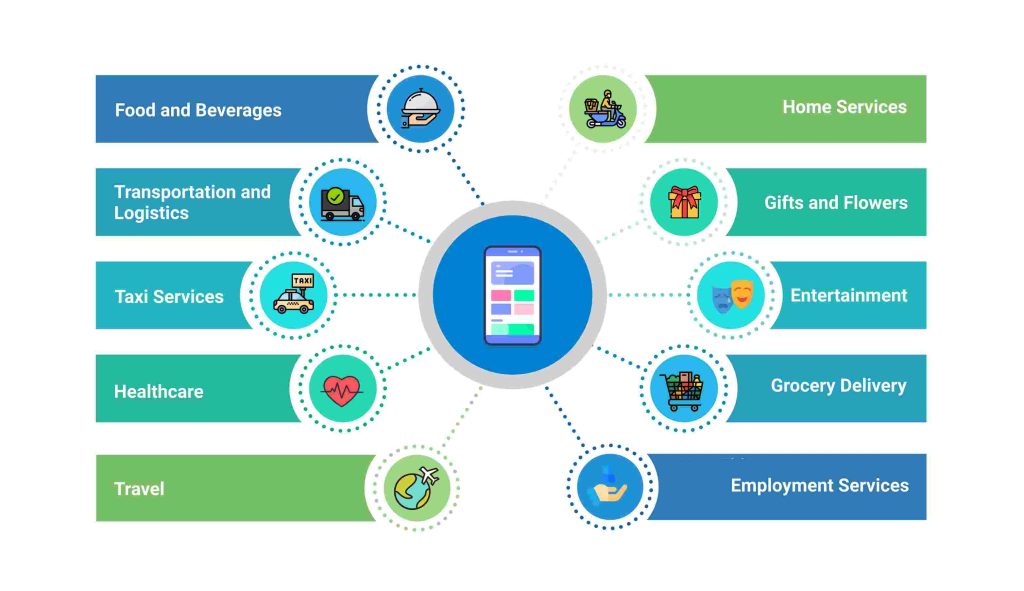
On-demand delivery apps are marking their existence in high-end sectors and local sectors alike. Since they fit well in all kinds of markets and provide excellent value, they are widely accepted.
Let me take you through the top 10 industries where on-demand delivery apps have excellent market potential.
1. Food and Beverages
Who doesn’t like to eat tasty restaurant food? And when you can get it without having to step out of your home! Perfect, right?
The demand for food will never end, and that makes it one of the most popular sectors for on-demand delivery apps. The food delivery apps like UberEats, Swiggy, Zomato, etc., have already transformed the food delivery industry with their exceptional services.
The importance of food in our daily lives and the convenience that food delivery offers makes it a business with endless possibilities. Since the food industry is diverse, food delivery app development has excellent scope if you can provide unique features and valuable service.
2. Transportation and Logistics
Transportation and logistics is an area where there happens a lot of confusion and lack of clarity. On-demand delivery apps have succeeded in bringing transparency to this sector.
With features like real-time tracking, in-app messaging, and transparent pricing, these apps have simplified transportation and logistics services. With it, people can transfer parcels in an easy and transparent way and keep track of their deliveries.
Uber Freight and Uber Deliver are two popular on-demand delivery apps in this sector. But there is a vast potential that can be exploited by newcomers, so logistics app development has a lot to offer if you are interested in on-demand app development.
3. Taxi Services
The influence of on-demand services on the taxi industry is so much that Uber has become synonymous with taxis today. Uber revolutionized the commuting sector by changing the way people hailed taxis.
Following its success, several taxi apps like Uber came into existence. The success of these apps can be attributed to features such as
- Save time and find taxis nearby using GPS
- Communicate with drivers
- Track taxi status at any time
- Find reliable taxis with the help of feedback from others
Taxi app development is a promising venture for entrepreneurs, rental services, and traditional taxi businesses.
4. Healthcare
One of the most beneficial sectors where on-demand delivery apps have marked their presence is in healthcare. On-demand healthcare apps let doctors and patients connect to each other anywhere and anytime.
It is helpful for older people to get professional healthcare services at home. It also enables people to access healthcare during emergencies right from their smartphones.
Healthcare app development further extends to provide services like appointment booking, fitness, and diet tracking, medicine delivery, electronic healthcare management, etc.
5. Home Services
Finding reliable home services was something people used to struggle with. Inspired by this market demand, several mobile app development services came up with on-demand apps that provided home services.
Home cleaning, plumbing services, electrical services, home maintenance- these apps offered a solution for all these problems. The quickness of these services and reliability made them popular among people.
HomeJoy, Handy are two well-known on-demand delivery apps in the home services sector.
6. Gifts and Flowers
In today’s busy lifestyle, people find it challenging to make time for buying gifts for dear ones. Sometimes you might remember about getting a present at the last moment, and by then it would have become too late to find a good one.
On-demand delivery apps like UberFlowers, Gyft, UrbanStems take care of this problem. They provide a wide range of gifts and flowers you can choose from and deliver them where you desire.
Features like doorstep delivery, delivery at the scheduled time, etc., make it a fantastic way to surprise your loved ones with gifts.
7. Entertainment
To meet changing customer behavior, the entertainment industry has also embraced the on-demand culture. From movies to music, TV shows, and games, on-demand delivery apps have entered into all.
It allows people to watch their favorite show or listen to any track, from anywhere and at any time. Compared to traditional services, it offers convenience and more value for money.
Netflix, Amazon Prime, Spotify, etc., are some of the most used on-demand entertainment apps.
8. Grocery Delivery
Like food, grocery is an integral part of people’s everyday life. Grocery app development has boomed since the pandemic. As people couldn’t go out due to lockdown, they relied on grocery delivery to have their needs met.
From fruits and vegetables to staples, dairy products, meat, and fish- grocery delivery services are exploring all possibilities. Understanding the vast market that it has, e-commerce giants like Amazon, Flipkart, etc., have ventured into grocery delivery.
Dunzo, Bigbasket, Grofers, etc., are some of the popular grocery delivery apps.
9. Travel
On-demand apps have touched several aspects of the travel industry. Whether it is booking a hotel, finding tourist spots, availing of car rental services, on-demand apps have a solution for all.
Apps like Airbnb, HotelToday, etc., simplify travelers’ lives to a great extent by allowing them to access necessary services and information easily from their smartphones.
On-demand travel apps have become a necessary travel companion for the new generation of travelers.
10. Employment Services
The job industry is going through a significant change. People are interested in doing flexible jobs rather than following the traditional office culture. Thus, freelancing is going on the rise.
Job seekers want short-term projects. It benefits the employees as well, as it will help to reduce costs. To supply for these changing job demands, on-demand employment services are becoming a great help.
It lets job seekers connect to job providers and find the type of job they are interested in. It brings transparency to the whole process. On-demand employment services have a huge potential in the future due to changing workforce culture.
What is the Execution Flow of On-Demand Delivery Apps
The execution flow of on-demand delivery apps are simple and straightforward. It involves five steps.

1. Request
A person finds some goods or services that they are interested in and requests the provider for it.
2. Approve/Reject
The provider receives the request and either approves or rejects it depending on factors like availability, location, etc. Either way, they send appropriate confirmation messages to the intended recipient.
3. Track
Once the request is approved, the provider places the order. The user can track the order’s status, like whether it is dispatched, in transit, etc., from within the on-demand delivery app.
4. Delivery
The ordered product or service reaches the user successfully.
5. Review
The user reviews the order and rates it. From the provider’s service to the quality of the product, detailed feedback is given by the user.
This is the basic execution flow of on-demand delivery apps. Depending on the type of app, there might be changes in this flow.
What are the Important Features of On-Demand Delivery Apps
An on-demand delivery app consists of three main parts- customer/end-user, admin, and driver/delivery.
Let us take a look at each of these separately and see what are the features each requires.
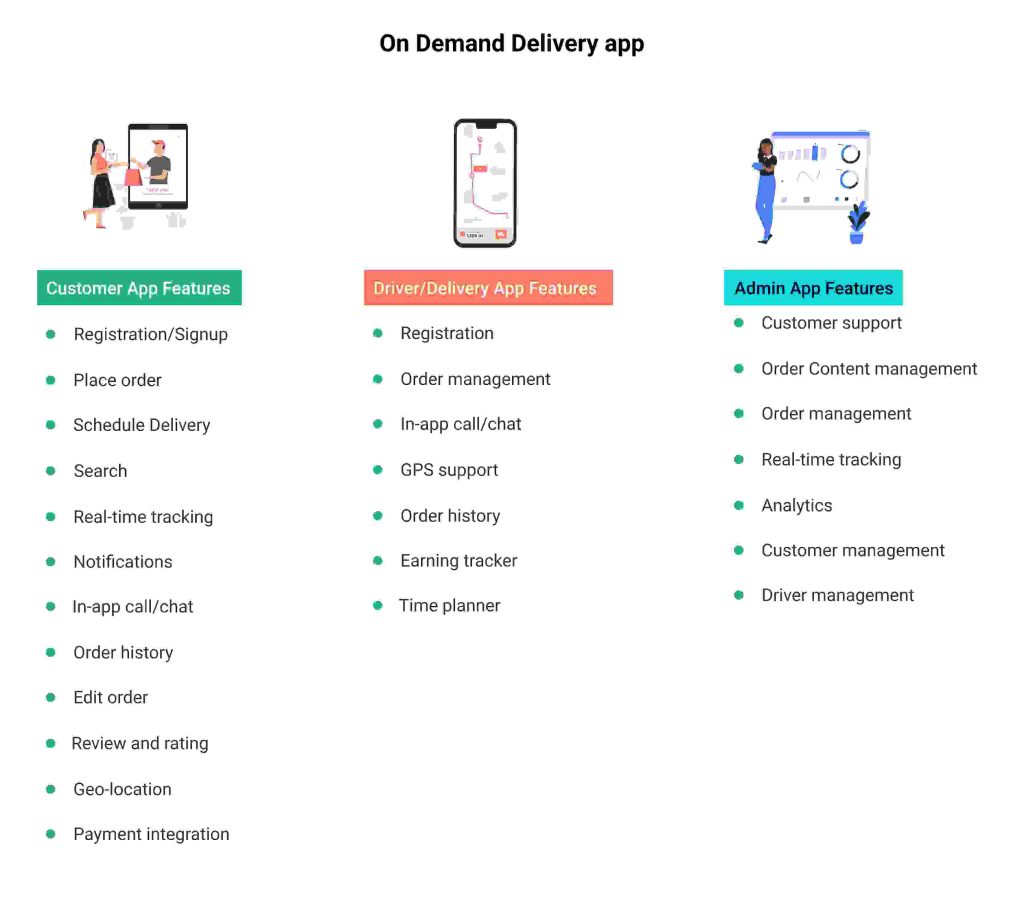
1. Customer App Features
The customer app is the one that is designed for the end-user who is looking to avail the products or services. The must-have features for customer app are:
1.1. Registration/Signup
A user must be able to register in the app using their email id, phone number, or social media accounts. This helps them to manage their accounts easily. The registration page should be simple and easy to fill.
1.2. Place Order
A user can place an order for interested items by adding them to the cart. A user should be able to place multiple orders and add items to a wishlist if they want to save them for future orders. Users should be able to give necessary information for order placement like delivery address, delivery time, etc.
1.3. Schedule Delivery
This feature allows a user to schedule a delivery according to their preferred time.
1.4. Search
A search feature is required to make it easy for users to find what they are looking for. The search bar should be visible at all times and should provide relevant results to users.
1.5. Real-Time Tracking
It is an important feature that allows users to track the progress of their orders, like order status, current location, etc.
1.6. Notifications
Notifications are essential to let customers know about special offers or real-time status, etc. Push notifications that inform customers about delivery status, order confirmation, etc., are common in on-demand delivery apps.
1.7. In-App Call/Chat:
This feature allows customers to contact the delivery person from the app itself to provide any update or clear any query.
1.8. Order History:
Users should be able to view all the orders that they have made through the app and repeat any order if required.
1.9. Edit Order:
A user should have a provision to edit their order, like cancel or reschedule depending on their convenience.
1.10. Review and Rating:
This is a great feature that lets the user give feedback about the service or delivery. It helps other users in their purchases and also allows providers to improve their service.
1.11. Geo-Location
Geo-location provides a customized experience to users by helping them find products or services that are near their location.
1.12. Payment Integration
Users should be able to choose between multiple payment options like credit/debit cards, COD, or online money transfer apps. THe payment services should be safe, reliable, and fast.
2. Driver/Delivery App Features
These apps are designed for people who are the providers or delivery agents of goods and services. Their features include:
2.1. Registration
Providers or delivery agents need to register with the on-demand delivery app to be able to provide their services to customers.
2.2. Order Management
They should have the authority to view all the orders coming and choose between accepting or rejecting order requests.
2.3. In-App Call/Chat
An in-app chat feature will allow them to communicate directly with customers from the app if there are any doubts regarding location or order details.
2.4. GPS Support
It is a must-have feature for delivery agents. Since they will have a lot of packages to deliver, GPS support will help them find destinations in a fast and accurate manner.
2.5. Order History
This feature will allow the providers to get the complete history of all the orders they have received. They can view order status, order details, etc., from the order history option.
2.6. Earning Tracker
This feature lets the providers keep track of their earnings. This helps them better manage their finances.
2.7. Time Planner
The delivery agents should have a provision to choose the time where they will be able to offer their services. Their availability should be planned in advance and recorded in the app.
3. Admin App Features
An admin takes care of the overall functioning of the on-demand delivery service through the admin app. The features it should have are:
3.1. Customer Support
An essential feature of the admin app is customer support. It allows them to communicate with customers and solve any issue they may have.
3.2. Content Management
Admin has the power to add the product or services that the app offers, update their details, etc. This is achieved through the content management feature.
3.3. Order Management
Admin can see all the orders that were received in the app. This helps them analyze the business track, solve any disparities, and work better to increase profits.
3.4. Real-Time Tracking
This feature allows the admin to track the delivery agents to ensure they are delivering orders correctly and on time.
3.5. Analytics
Admin can get an overall insight into the app usage through a dashboard feature. This allows the admin to view their user base, total order statistics, sales statistics, etc. Admin can find areas of improvement from analyzing these insights.
3.6. Customer Management
Admin can maintain activities related to customers like discount programs, referral programs, etc., through the customer management feature.
3.7. Driver Management
Assigning tasks for delivery agents, managing their earnings, shifts, incentives, etc., are handled by admin through this feature.
How to Build an On-Demand Delivery App
Do you have any unique mobile app ideas that you want to develop into an on-demand delivery app? Then, let me take you through the steps involved to create a mobile app.
Step 1: Create a Software Requirement Specification (SRS)
An SRS is a document that gives a complete description of the software that is to be developed. The first step of building an on-demand delivery app is to create this SRS. For that, you need to collect information about everything that you want to include in your app.
The best approach for this is to create a list of questions and answer them. You can ask questions like:
- Who is your target audience going to be?
- What unique features will you provide them?
- What are the challenges you want to overcome?
- Which platform do you want to design your app for?
- What is your estimated app development budget?
- How will you price your services?
The answers to these questions will help you create an SRS that you can discuss with your stakeholders and the development team.
Step 2: Move on to Design
The next step is to hire a mobile app development company to help you put your requirements into reality. You can choose to outsource app development, find freelance developers, or develop with on-demand app builders.
In this step, you work on the visual and technical aspects of your on-demand delivery app. By creating wireframes and low-fidelity prototypes, you can build a skeleton of your desired app. You can also create high-fidelity prototypes that replicate the final product in all ways.
The prototypes can be reviewed with your stakeholders or put through some user testing to determine areas of improvement. These can then be redesigned till the desired output is achieved.
Step 3: Create a Minimum Viable Product (MVP)
Before you release your final app in the market, it’s best to create an MVP with minimum features. MVPs are released to a limited audience, usually a subset of the potential audience, and are designed for early testing.
The focus of MVP is to find issues related to the product early on and fix them in a simple and cost-effective manner. It helps you to create a more efficient final product and reduces the effort and expenses related to rework on products after the final release.
The release of the MVP product increases the success rate of launching a final product. It is an excellent method to get hands-on feedback from real users with the least effort and minimum expense.
Step 4: Launch Your Final Product
Once you released your MVP and integrated the feedback received from it, you are ready to launch the final product.
Ensure that your final product is efficient and of high quality by performing several iterations and implementing an agile development process. Integrate the latest mobile app development trends in your app to make it competitive.
With the help of your development team, you can publish your app into the App Store or Play Store to make it available to the public.
Your development team will also help you in the marketing of your app to reach out to more people.
What are the Top 7 Ways to Grow Your On-Demand Delivery Business
The on-demand marketplace is very competitive. So it is essential to take actions that would help your on-demand business grow. To grow and retain your user base, you can adopt the following strategies with your on-demand delivery app.
1. Marketing
Marketing is a tried and tested strategy to promote any business.
You can do pre-launch marketing before launching the on-demand delivery app. This will let more people know about it.
You can advertise your app on social media platforms and appropriate channels to attract users.
Referral programs, limited period offers for downloading the app, etc., are some great ways to get new people interested in your app.
2. Collaborate With Local Partners
Collaborating with local partners will greatly help to increase the reach of your app.
You may not be able to cover all the markets if you operate alone. Local partners will help you reach undiscovered markets and grow your user base.
Collaborating with retailers also is a great way to enhance your app. The success of hyperlocal delivery models shows how important delivery services are for small localities.
3. Offer Rewards, Discounts, and Incentives
Users love offers!
Discounts and offers are sure to attract more users to purchase with your app. It will help you gain attention and expand your user base.
Offering rewards, incentives, and loyalty programs are found to increase user retention and improve business.
4. Personalization
An effective technique used by e-commerce applications in maintaining user retention is personalization.
Personalization involves providing your user’s personalized suggestions or services based on their previous purchase history.
This makes customers feel special and also saves their time by helping them shop quickly.
5. Push Notifications
When used the right way, push notifications are an excellent strategy to get users to shop with your app.
By providing personalized push notifications about limited offers or location-based services, you can lure users into making purchases.
It helps to improve engagement and also serves as a reminder to the users about your app.
However, you should take care not to overuse it as it will end up annoying the customers.
6. Customer Support
A customer support section is essential to build a relationship with customers and the on-demand service.
When customers have a platform to raise their concerns and address their problems, it creates a feeling of trust in them.
Knowing that if anything goes wrong with their order, they can approach customer support will empower more people to purchase without doubts.
7. Customer Feedback
A feedback system is an amazing approach to better your on-demand delivery app.
When you take regular feedback from your customers, you can identify areas of improvement and enhance your service to take care of those issues.
The ratings given by customers can also help to build your reputation and attract new users.
What is the Cost of Developing On-Demand Delivery Apps
The cost of developing an on-demand delivery app depends on the type of the app, its functionality, features, etc. You can create progressive web apps, native apps, or cross platforms apps. The cost to develop a mobile app will vary depending on the type you choose.
To develop a basic on-demand delivery app, the cost would range between $15000 to $45000.
For a basic app, the cost of development can be broken down as:
- Documentation – $1000 to $2000
- UI UX Design- $1500 to $3000
- Front-end and back-end development- $6000 to $20000
- Testing- $2000 to $4000
It can vary depending on the hourly rate that the development team charges, the requirements of your on-demand app, features to be integrated, etc.
Build Your On-Demand Delivery App Today!
The on-demand economy is thriving today, and it is not a short-term trend. It is going to be the future of e-commerce. Understanding this, most services are making their entry into the on-demand culture. If you want to develop an on-demand delivery app, now is the right time to get into action.
Mindster is a leading mobile app development company with extensive experience in developing on-demand applications. We have successfully developed several on-demand applications in various verticals like healthcare, the beauty industry, fuel delivery, digital magazines, etc. Get in touch with us to discuss your mobile app development idea!
- Agentic AI1
- Android Development3
- Artificial Intelligence30
- Classified App3
- Custom App Development5
- Digital Transformation12
- Doctor Appointment Booking App14
- Dropshipping1
- Ecommerce Apps40
- Education Apps2
- Fintech-Apps37
- Fitness App4
- Flutter4
- Flutter Apps20
- Food Delivery App5
- Grocery App Development1
- Grocery Apps3
- Health Care9
- IoT2
- Loyalty Programs9
- Matrimony Apps1
- Microsoft1
- Mobile App Maintenance2
- Mobile Apps124
- Product Engineering6
- Progressive Web Apps1
- React Native Apps2
- Saas Application2
- Shopify9
- Software Development3
- Taxi Booking Apps7
- Truck Booking App5
- UI UX Design8
- Uncategorized6
- Web App Development1








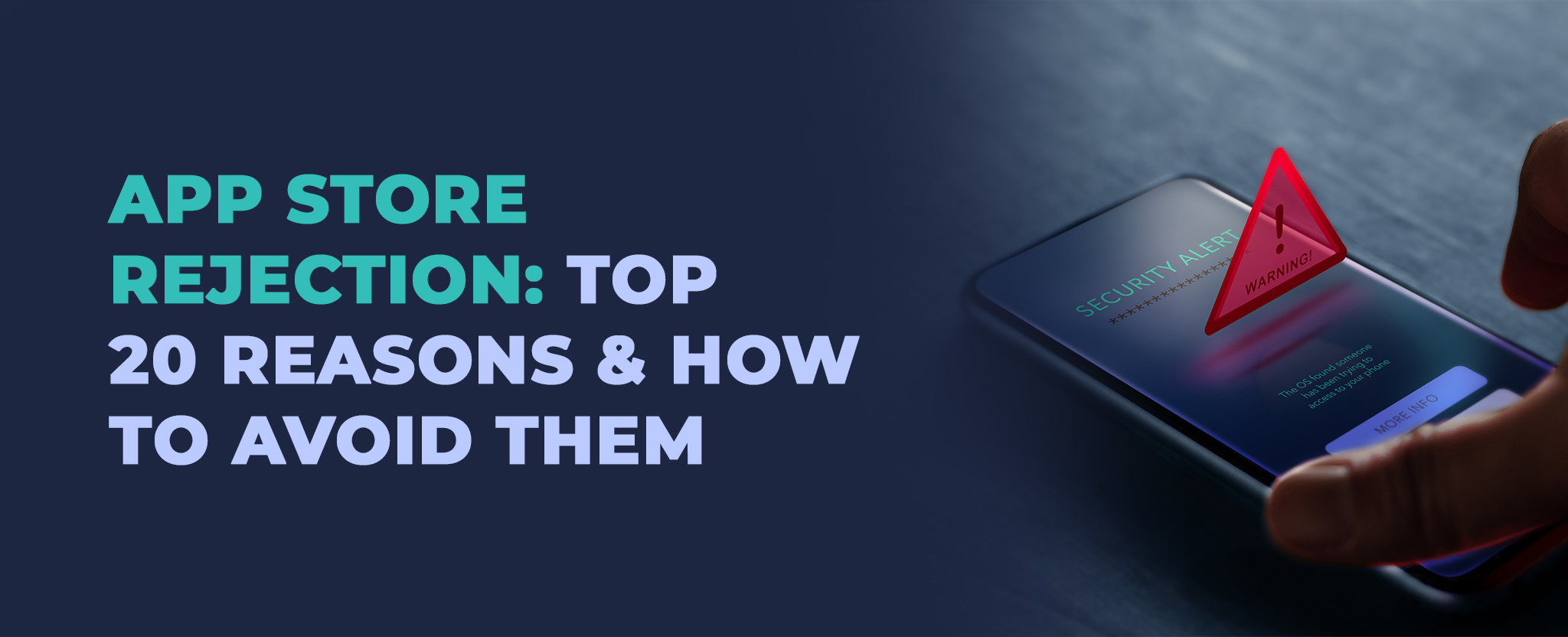
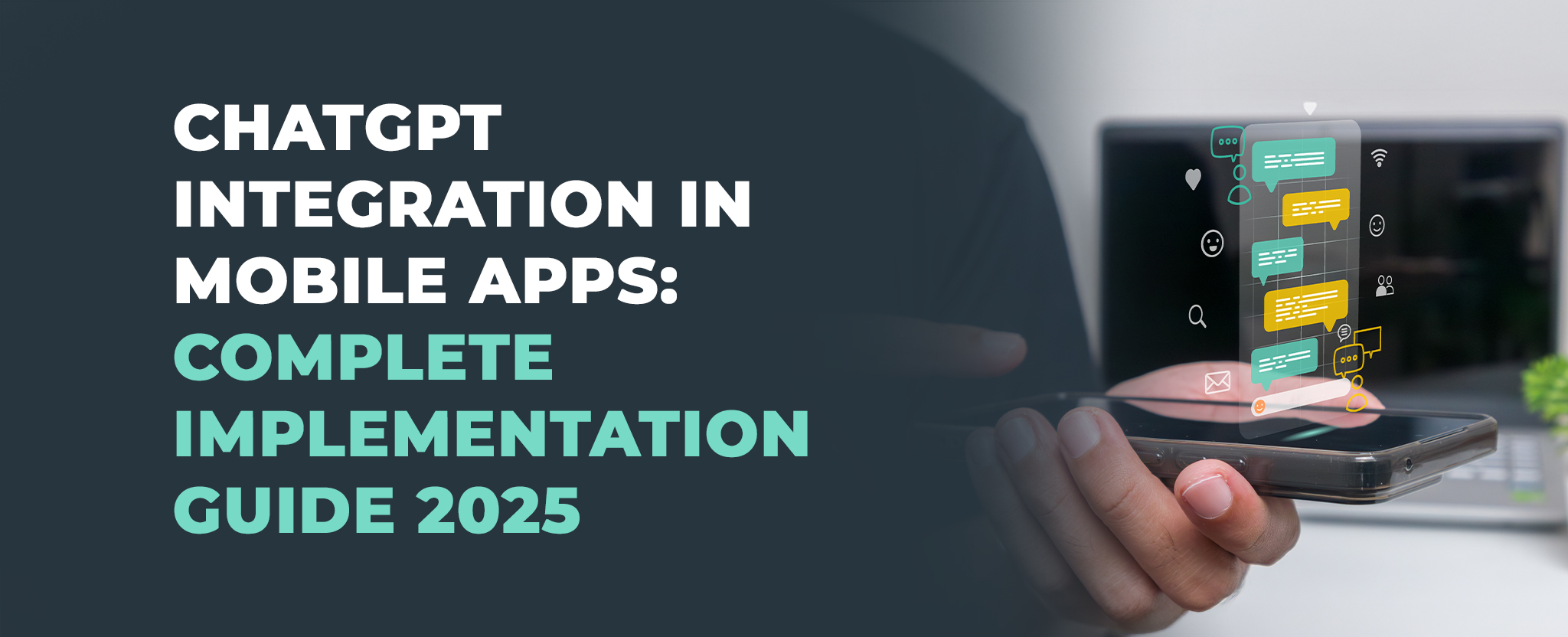

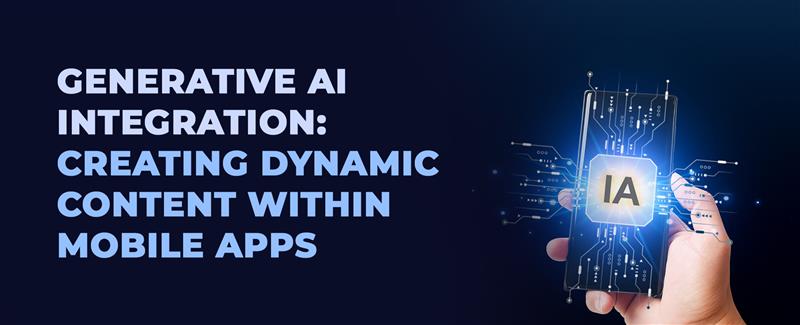






[…] Uber is the best example. The ride reaches you within the minimum time once the booking is made. On-demand delivery apps require even more features and user interfaces. They are gaining traction in the digital pathway. […]